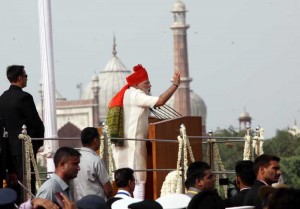What we saw at Red Fort was not Modi the politician or even Modi the PM. It was Modi the pracharak, holding forth on naitik shiksha, or moral education, at the largest shakha ever assembled, say columnist Mihir Sharma, raising an oblique voice through his column in Business Standard, contesting commentators who praised the maiden speech.

“This is not the speech that any one of us was expecting.Narendra Modi was supposed to declare the Second Republic from the ramparts of the Red Fort. He was supposed to declare the end of the corrupt idea-of-India Congress-tainted state that was holding back Resurgent India. Had he not, on the campaign trail, insisted that this was truth? Do not his adoring followers share this sense of history, and are they not similarly aggrieved, and hopeful of a Refoundation, of a second Independence, of a Tryst with Destiny rewritten for the Hindutva age? Instead, the prime minister praised the Constitution, and its framers, and the prime ministers before him, and the governments that had built the first and as yet only Republic for 67 years – and even the existing political opposition, he argues.
“Narendra Modi was supposed to declare a radical reformist vision to fit an India middle-class and not poor. He was expected to declare an India free of the enervating legacy of handouts, an India where economic liberalism holds sway, where Hayek is translated into Hindi and read on every street-corner. Was that not what his hopeful free-market fans expected, hopefully repeating that one “minimum government, maximum governance” phrase as if it were carved in nine-foot letters on a giant stone statue to Margaret Thatcher? But instead the prime minister came back, again and again, to “garibi hatao” (abolish poverty), to a government focused on India’s poor. He attacked imports, announced a debit card with overdrafts for the poor, praised the bureaucracy, promised funding for “model villages”, and compared the fight against poverty to the freedom struggle,” he adds.
“Narendra Modi was supposed to declare the advent of a new, muscular India, an India that had left behind the wimpishness of the past, that would not be pushed around by China and Pakistan and foreign capital and what have you. Is that not what he promised on the campaign trail? Is that not what a legion of frustrated young male fans thought they saw in him – a man who will tell every enemy of this country where to get off? Instead, the prime minister spoke only of his happiness that the leaders of India’s neighbours had come to his swearing-in, and suggested we together fight poverty – through welcoming foreign capital, among other things.
Narendra Modi was supposed to declare that India was no longer ashamed, to defend Indian Culture from the assaults of these serpent-tongued children of Macaulay, to comfortingly blame the victim and the state for the horrors of life in India. Is that not the hand-holding that we expect from a true leader? Instead, the prime minister reproved Indian parents for exalting boys over girls, for permitting rape culture, and for thinking of it as a “woman’s problem”, and not one a problem caused by men. Instead, he spoke of our greatest national shame, a culture of open defecation and poor hygiene, openly and frankly,” argues Sharma.
“Narendra Modi was supposed to declare that the problems of the country were questions of leadership alone and not of institutional rot, to indicate that matters were in hand and that his very presence would transform India’s creaking state from an Ambassador to a BMW. Is that not what he promised in his campaign, a campaign focused sharply on his own virtues and not the state’s failings or the need for reform? Instead, the prime minister’s very first point was to stress that the Centre is divided, with each department run like a jagir (fief), and that he had tried to break down the walls between the wings of government – but that it was up to the entire bureaucracy to pull together, and to perform to its potential, if India is to progress.
“Narendra Modi was supposed to say and do many things through his first Independence Day speech. But, in the end, the speech he delivered was one most unexpected. What are we to make of this prime minister, the one who condemns communal violence – yet asks not for a permanent cessation in the killing, but a temporary one, for 10 years? Of this prime minister, who delivers an I-Day address that is not a list of achievements, or a set of promises, or a broad statement of vision, but a lecture and a sermon and an exhortation,? he wonders.
Sharma says that perhaps the most sensible way to think of Modi’s first speech from the Red Fort is that he finally shows an understanding of both the limits and the possibilities of power. “The limits of a prime minister’s power are considerable; he cannot fight the lethargy, or the corruption, or the violence of his people. But the possibilities of power are also considerable; when you are as adored as Modi is, you have the attention of a vast audience, and you can try to change who they are. When you are seen all our brilliant under-30 compatriots as a cross between N R Narayana Murthy, Ramdev and Salman Khan, you can urge internal change on them in a way that no politician in generations has been able to. You do not need to promise; you can demand.”
And Modi has a template from his past, after all, for such sermons. What we saw on the Red Fort’s ramparts was not Modi the politician, not even Modi the prime minister. It was Modi the pracharak, holding forth on naitik shiksha, or moral education, at the largest shakha ever assembled, he concludes